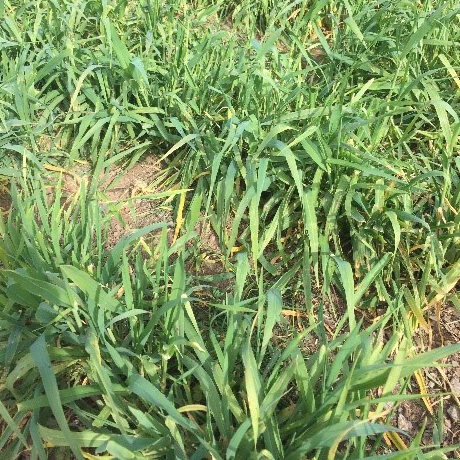Managing your grazing cereals to maximise production – Nitrogen application
By Callen Thompson, Senior Local Land Services Officer – Mixed Farming
Given the lack of rain, the area in which this story is relevant is rapidly decreasing, but as I have had a few questions on the topic recently, I thought I should still address it.
Nitrogen is a major driver of dry matter production in winter cereals. In a production system where there is a number of years of Lucerne/legume pasture between cereal crops, it is possible to produce enough nitrogen for the following cereal crop, but for most situations, nitrogen needs to be applied to get optimum production. Nitrogen can be applied pre-plant or applied at sowing. To apply at sowing you will generally need to be able to place fertiliser away from the seed as the rate needed will burn the germinating seed, reducing germination. It is very common practice to apply nitrogen in-crop. That is what I will address in this article.
The first step in applying any fertiliser is to do a soil test. When testing for nitrogen it is important to sample at depth as nitrogen is one of the most mobile nutrients in the soil. The depth you sample down to is dependent on the plant available root zone, but is generally between 60 centimetres and 1 metre. If you are in a situation where you have subsoil constraints such as acidity or sodicity, the nitrogen in the subsoil may not be available to the plant.
You can take one sample which will tell you how much nitrogen is in the profile, or take a number of samples (0-30, 30-60 for instance). Taking samples through the profile allows you to see where the nitrogen is, which can help with timing as well as elimination the chance of a nitrogen bubble at depth, which would not become available until later in the growing season.
Once you know how much nitrogen is in the soil, you can then work out your desired nitrogen rate. In a normal season, it would not be unrealistic for a dual purpose wheat to grow 4t/ha of dry matter and 4t/ha of grain. Work published by Bob Freebairn, suggests that this crop would require 224kg of nitrogen per hectare. Not all of this nitrogen would be removed. The majority would be returned through crop wastage, urine and dung. Unfortunately the nitrogen in these waste products will not be available to the plant within the growing period. Table 1 shows nitrogen requirements for growing winter wheat vs the nitrogen removed in grain and meat.
Table 1: Nitrogen requirement vs nitrogen removal of a winter wheat crop (Adapted from Freebairn 2005)
Dry matter yield (t/ha) | Grain yield (t/ha) | Nitrogen required to grow crop (kg/ha) | Nitrogen removed in grain and meat (kg/ha) |
2 | 2 | 112 | 55 |
2 | 4 | 154 | 101 |
2 | 6 | 196 | 147 |
4 | 2 | 182 | 64 |
4 | 4 | 224 | 110 |
4 | 6 | 266 | 156 |
6 | 2 | 252 | 73 |
6 | 4 | 294 | 119 |
6 | 6 | 336 | 165 |
There are a number of products that you could use to apply your nitrogen. Urea is the most common, but some producers will use sulphate of ammonia, especially if they would like to increase soil sulphur levels for other crops within the rotation. Sulphate of ammonia is twice as acidifying as other nitrogen products, so should be avoided on low pH soils. Liquid products such as UAN (urea and ammonium nitrate) can be faster acting, but generally come at a greater cost per kg of nitrogen.

Image: Yellowing of older leaves is a good indicator of nitrogen deficiency.
One of the risks when topdressing nitrogen is through volatilisation. Volatilisation occurs when ammonium fertilisers are applied to the soil surface. Ammonium converts to ammonia gas and is then able to blow away. Volatilisation rates increase with increased moisture (wet soil surface) and increased temperature. Because of this, it is preferable to apply products like urea prior to a rainfall event so that the ammonium moves into the soil with water. As a young agronomist I was told that under adverse conditions, losses could be anywhere between 25-50 percent. Because of this producers would not apply urea unless there was a good rainfall forecast, often missing out on crop yield as they didn’t want to take a risk on a low chance of rain.
Work done by Graeme Schwenke, NSW DPI in 2012-13 indicates that the level of loss in an in-crop situation may not be as high as we once thought. Graeme’s trials were conducted on vertosol soil in a tillering wheat crop. Urea was broadcasted on top of the soil in a tillering wheat crop. Measurements were taken for the next four weeks. Levels of loss over seven paddocks ranged from two to nine percent, with an average of five percent loss. In the same project losses on fallowed country averaged 11 percent.
From this work we can see that urea losses on vertosol soils with good canopy closure is low. It is possibly a better option to get urea onto the paddock once the crop has had canopy closure and wait for a rain fall event. Levels of loss may be higher on lighter soil types and soils with low pH. Be mindful that the crop will not be able to access the nitrogen until there is sufficient rainfall to wash it into the root zone.
The following agnote provide more information on productive dual purpose winter wheat:
Graeme Schwenke’s paper on nitrogen volatilisation can be found here:
If you would like more information on fertiliser application for your crops, contact your Local Land Services Ag Advisor.